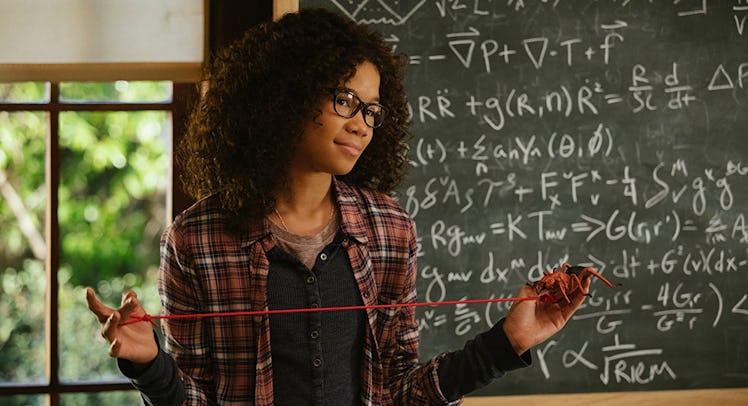How Parents Can Talk About ‘A Wrinkle In Time’ With Young Kids
Despite lukewarm reviews, the new Disney blockbuster should help parents have valuable conversations with their kids.

Powered by the Disney marketing machine, A Wrinkle In Time has almost certainly invaded your headspace over the last few months. Director Ava DuVernay’s adaptation of Madeleine L’Engle’s classic name was finally released into US theaters this week and, despite tepid reviews, the movie will almost certainly pull in millions over its first weekend that to the strength of the source material and a star-studded cast (Oprah, Reese Witherspoon, Chris Pine, and everyone else). Parents who go in with even slightly lowered expectation for the epic, will likely have a good time. It’s not an un-fun watch. It is also a good conversation starter.
Hiding beneath the bright colors and megawatt smiles are some mature themes that should leave children of all ages wanting a discussion post-watch. The story of Meg Murry (played ably by Storm Reid) isn’t just an adventure romp through time and space; it’s the tale of a daughter searching for her father and an outcast searching for somewhere she belongs.
Accompanied by her wunderkind little brother Charles Wallace and her crush Calvin, Meg confronts the darkness in the universe and, climatically, the darkness in herself. Things get a bit real and, along the way, the movie explores the value of self-confidence, the difficult-but-necessary need for empathy, and topics related to adoption. Given all that, parents headed into the universe of tesseracts, camazotz, and The It, should do a little prep for one of the four conversations that will likely follow.
Conversation One: The Power of Self-Love
If there is one main theme in A Wrinkle In Time, it is the value of self-love. After her father disappears, Meg struggles with her self-image and acts out due to a rage derived from feeling unwelcome in your own world. She struggles to be a good kid. And that only changes once Meg learns to tesser, or wrinkle time and space, in order to search for her father.
Without spoiling too much, it’s worth saying that Meg can’t save her father until she learns to love herself. Reese Witherspoon’s Mrs. Whatsit says it best, explaining to Meg that her faults make her beautiful. That sentiment is mirrored by Oprah’s Mrs. Which, who begs Meg to see that she is the product of an untold number of moments and should take pride in that.
As this is a kids movie from a major studio, parents can probably guess that it all does turn out fine in the end, with Meg learning to love herself and others. That doesn’t make the impact of her realizing that there’s beauty and value within herself any less affecting.
Conversation Two: Empathy For Bullies
While the movie centers on Meg and asks you to sympathize with her loneliness at school, it also pulls a neat trick when it comes to her tormentors. During an explanation of the overwhelming power of The It, the movie cuts to some of the minor antagonists that have directly or indirectly affected the Murry family and tries to explain their situations, creating empathy.
The teachers that were openly mocking the Murry family? They are consumed with jealousy over not being promoted. Calvin’s father, who berates his son over a B- test score? He’s filled with rage over not being good enough. Veronica, Meg’s bully who mocks her father’s disappearance? She is in the throes of an eating disorder.
The movie doesn’t expect children to accept bullying as a part of life, but it does ask them to think about what pushes a person into bullying. Ultimately, Meg’s journey of self-acceptance eventually helps her liberate the bullies of their internal rage and torment, serving as a metaphor for how kindness can overcome even the most hurtful of bullying.
Conversation Three: Adoption
Charles Wallace is adopted and A Wrinkle in Time never hides that fact. Parents who have adopted children will likely have to have a conversation about Charles Wallace’s resentment and sense of not belonging in his own home. However, even families without adopted children should probably discuss how to talk about adoption. It’s a sensitive issue.
When discussing adoption, it’s important to not use essentialist terms like “real” or “natural” to describe parentage. Instead, children should be taught to use “birth parents” or “biological parents” when discussing that in terms of adoption.
Conversation Four: Heroic Women
A Wrinkle In Time is clearly intended to empower women and girls, but it’s not overt about that agenda. There is not a moment where a character acts surprised that the main character is a girl, or that the main all-powerful characters are all women. Four of the six main roles are played by women, a statistical anomaly for a $103-million blockbuster.
Similarly to how Black Panther started discussions about the representation of black people in Hollywood, A Wrinkle In Time can start conversations about how women and girls are represented in popular culture. To have powerful female characters, ones that are interested in science and math as much as they are matters of the heart, is both shocking and welcome. It’s worth focussing on it.
This article was originally published on